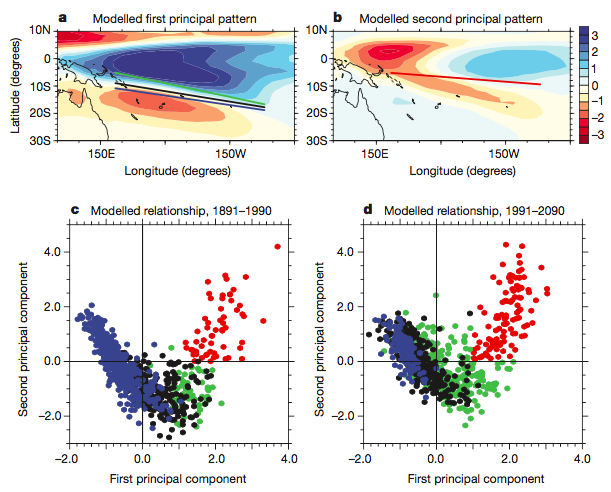More extreme swings of the South Pacific Convergence Zone due to greenhouse warming
Abstract
The South Pacific convergence zone (SPCZ) is the Southern Hemisphere’s most expansive and persistent rain band, extending from the equatorial western Pacific Ocean southeastward towards French Polynesia1, 2. Owing to its strong rainfall gradient, a small displacement in the position of the SPCZ causes drastic changes to hydroclimatic conditions and the frequency of extreme weather events—such as droughts, floods and tropical cyclones—experienced by vulnerable island countries in the region1, 2, 3, 4, 5, 6, 7. The SPCZ position varies from its climatological mean location with the El Niño/Southern Oscillation (ENSO), moving a few degrees northward during moderate El Niño events and southward during La Niña events2, 5, 6. During strong El Niño events, however, the SPCZ undergoes an extreme swing—by up to ten degrees of latitude toward the Equator—and collapses to a more zonally oriented structure5 with commensurately severe weather impacts5, 8, 9, 10, 11. Understanding changes in the characteristics of the SPCZ in a changing climate is therefore of broad scientific and socioeconomic interest. Here we present climate modelling evidence for a near doubling in the occurrences of zonal SPCZ events between the periods 1891–1990 and 1991–2090 in response to greenhouse warming, even in the absence of a consensus on how ENSO will change12, 13, 14. We estimate the increase in zonal SPCZ events from an aggregation of the climate models in the Coupled Model Intercomparison Project phases 3 and 5 (CMIP315 and CMIP5) multi-model database that are able to simulate such events. The change is caused by a projected enhanced equatorial warming in the Pacific16 and may lead to more frequent occurrences of extreme events across the Pacific island nations most affected by zonal SPCZ events.


